“Tiffin: 500 Authentic Recipes celebrating India’s Regional Cuisine” by Sonal Ved
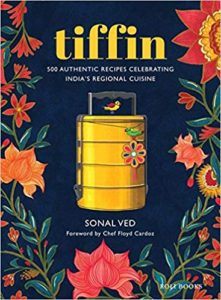 Vogue India’s food editor Sonal Ved’s Tiffin has just been published by Roli Books. Tiffin is a collection of 500 recipes, dishes that are usually sampled as school children when sharing each other’s tiffins during lunch break, a habit that continues into adulthood when sharing food with colleagues. Tiffin intends on celebrating this incredible richness of India’s regional cuisine and to create a repository of varied culinary traditions.
Vogue India’s food editor Sonal Ved’s Tiffin has just been published by Roli Books. Tiffin is a collection of 500 recipes, dishes that are usually sampled as school children when sharing each other’s tiffins during lunch break, a habit that continues into adulthood when sharing food with colleagues. Tiffin intends on celebrating this incredible richness of India’s regional cuisine and to create a repository of varied culinary traditions.
While most of these [recipes] have been hand-picked by culinary experts from each region, we went beyond, and reached out to the best repositories of traditional recipes — wedding caterers, who are given the responsibility of serving contemporary and traditional spreads. Each of the contributor recipes, which includes those given by grandmothers, mothers, aunts, friends, cookbook authors, and chefs who champion regional Indian cooking… .
Tiffin is a fabulous collection of recipes that cover the length and breadth of India providing a selection of recipes representative to the region. Whether it is the Goshtaba recipe from Kashmir to Pesarattu dosa from Andhra Pradesh or even the Manipuri Iromba from the North East there is a wide variety of recipes included. The beauty of collecting these recipes in one volume is that it enables the learner or an experienced cook to experiment with dishes, even mix and match if need be rather than remain stuck within one regional fare. It is a great way of learning how to put the spices and ingredients to multiple uses while also expanding the menu at the dinner table. In the opening pages of the book there is a description of the basic spices and ingredients used as well as some basic processes on how to make paneer or khoya etc. While the recipes collected within every section can be considered as only a sample of the region, it is the introductory essays to the sections that are worth reading and bookmarking, perhaps even looking up the references on the Internet. For instance, in the essay on Central India there is a reference to Kamar Bhai’s shop in Bhopal that specialises in selling Paya ( Trotters) Soup, loaded with bits of meat.
Every single essay is beautifully presented packed with information but without it being too detailed. It is a great bird’s-eye view of the cuisines to be expected in the forthcoming section. A particularly good example of this is the essay on South India which encompasses the states of Telengana, Karnataka, Andhra Pradesh, Tamil Nadu and Kerala. This region is famous worldwide for its cuisine such as the dosas, vadas and idlis but the richness in the fare lies in its finer distinctions such as local produce (which is heavily dependant on factors such whether it is in the black soil region or the coast) or even religion as is found in Kerala. The state is known to be a gourmet’s delight 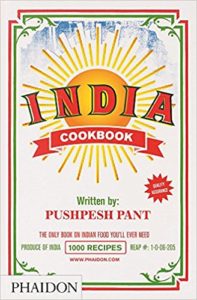 with its confluence of Christian, Muslim and Hindu culinary expressions and yet there are very distinct cuisines too. It is quite a feat to present these intricacies of the regional culinary mapping of India while not overwhelming the reader/cook.
with its confluence of Christian, Muslim and Hindu culinary expressions and yet there are very distinct cuisines too. It is quite a feat to present these intricacies of the regional culinary mapping of India while not overwhelming the reader/cook.
It is an incredible delight to behold a recipe book with such a sumptuous layout making it very dicey to carry it into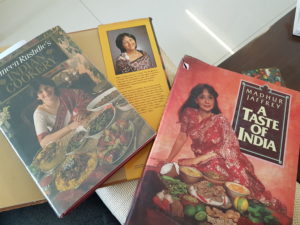 the kitchen to consult while cooking! Nevertheless it is a varied collection which has used recipes from the other marvellous Roli Books publication India by noted recipe columnist and author Pushpesh Pant. Some of the other notable Indian cookery book writers were Madhur Jaffrey, Meera Taneja and Tarla Dalal who paved the way for a new generation of cookery book writers to explore regional distinctions such as presented in Tiffin. In fact Sameena Rushdie’s phenomenal cookery book Indian Cooking ( published in 198) has just been reissued. Her description of collecting recipes is an age-old process whether passed on from generation to generation or exchanged across the dining table but the methodology for collecting recipes is only hinted at in Tiffin’s introductory essay. To describe the process can be quite tedious but here are two snapshots from Sameena Rushdie’s book attempting to note down the “Aloo Goshtaba” recipe from her mother which explain this process beautifully.
the kitchen to consult while cooking! Nevertheless it is a varied collection which has used recipes from the other marvellous Roli Books publication India by noted recipe columnist and author Pushpesh Pant. Some of the other notable Indian cookery book writers were Madhur Jaffrey, Meera Taneja and Tarla Dalal who paved the way for a new generation of cookery book writers to explore regional distinctions such as presented in Tiffin. In fact Sameena Rushdie’s phenomenal cookery book Indian Cooking ( published in 198) has just been reissued. Her description of collecting recipes is an age-old process whether passed on from generation to generation or exchanged across the dining table but the methodology for collecting recipes is only hinted at in Tiffin’s introductory essay. To describe the process can be quite tedious but here are two snapshots from Sameena Rushdie’s book attempting to note down the “Aloo Goshtaba” recipe from her mother which explain this process beautifully.
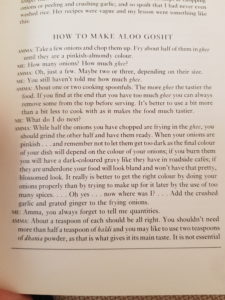
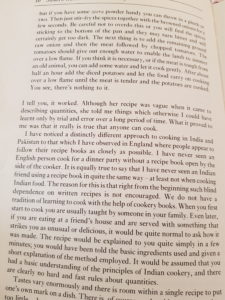
While Tiffin includes some of the well-known dishes like Khandavi ( Gujarat), Murgh Zafrani ( Uttar Pradesh), Haak ( Kashmir), Gatte ki Sabzi ( Rajasthan), Began Bhaja ( West Bengal), and Balushahi ( Bihar) there are many others that have been excluded such as Gulabjamuns or Kofta Curry. It is perhaps understandable given the limitations of space in a printed book. Perhaps a natural progression from having published this magnificent volume would be to begin a discussion forum online of food lovers who can share regional recipes. There are many such existing groups on social media but there is always room for another one especially when it becomes a digital and interactive extension of a printed commodity. It would also provide a platform to discuss variations on how to make a particular dish too. For instance the process described in Tiffin to make ghee (clarified butter) from cream is a tad complicated. While giving sound advice on removing the excess water from the cream before putting it on to cook, the description of a three-day process could instead have been of simply suggesting that the cream is collected regularly from the boiled milk over a period and then cooked on a slow flame till the ghee separates. A footnote added to the recipe could be that in some parts of north India the burnt cream residue left at the bottom of the dish is quickly mixed with sugar and eaten warm. A delicious sweet snack to combat the biting chill of north Indian winter. To prove how popular repository of recipes are take a look at the BBC Food — a phenomenal repository of recipes which went extinct in December 2008 and yet ten years on the archive is kept alive and open for users to browse through!
Given the stiff competition from online videos and recipe banks that are readily accessible it is always heartening to see a new cookery book in print. For an experienced cook these collections are always precious for it always helps to tickle the imagination by reading a few recipes to figure out what to prepare for the next meal or present as a new menu in a restaurant. At the same time Tiffin provides a critical function of taking ownership of the wide variety of regional Indian cuisine and hopefully preserving this knowledge of food systems for future generations as it is now slowly and steadily being eroded by modern lifestyles. Enthusiastic foodies have already begun leaving a digital trail of the variety of regional cuisines such as this article in Scroll about the various kinds of existing Indian cheeses like kalari, chhurpi and churu that have been eclipsed by paneer. Or that a Conde Nast award has been instituted for the best food writing and the shortlisted entries consist of articles on camel milk, bananas, or the food rituals associated with a funeral in Shamsabad.
Tiffin is a delightful addition to one’s cookery book collection. It will over time become a significant part of many household and commercial kitchens for it does provide an insight into a wide variety of processes of preparing even the basic Indian dishes.
To buy on Amazon India:
5 November 2018

